University Business Capstone: Uber Case Study Analysis
VerifiedAdded on 2022/10/12
|28
|7921
|145
Case Study
AI Summary
This case study analyzes Uber, a multinational transportation company, focusing on its business model, growth strategies, and challenges. The report provides a company overview, explores its diverse services, and examines its competitive landscape and the impact of surge pricing. A detailed literature review assesses Uber's business model, global competitive situation, and growth strategies. The study addresses key research questions, including how Uber's business model aligns with the "move fast and break things" adage, how it addresses its competitive situation, and the critical challenges facing the riding industry. The study concludes with recommendations for future improvements, offering insights into how Uber can enhance its services and address its challenges.
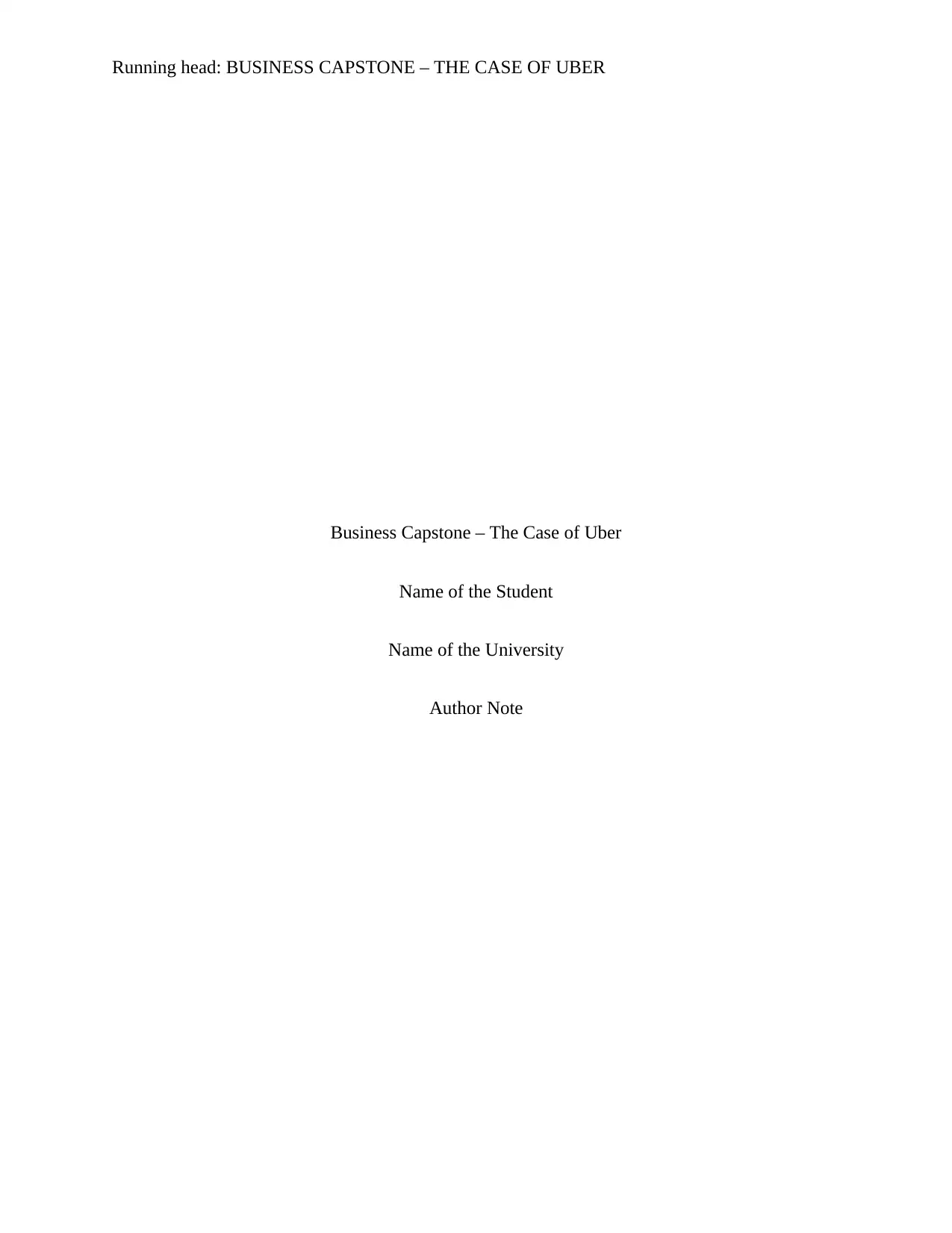
Running head: BUSINESS CAPSTONE – THE CASE OF UBER
Business Capstone – The Case of Uber
Name of the Student
Name of the University
Author Note
Business Capstone – The Case of Uber
Name of the Student
Name of the University
Author Note
Paraphrase This Document
Need a fresh take? Get an instant paraphrase of this document with our AI Paraphraser
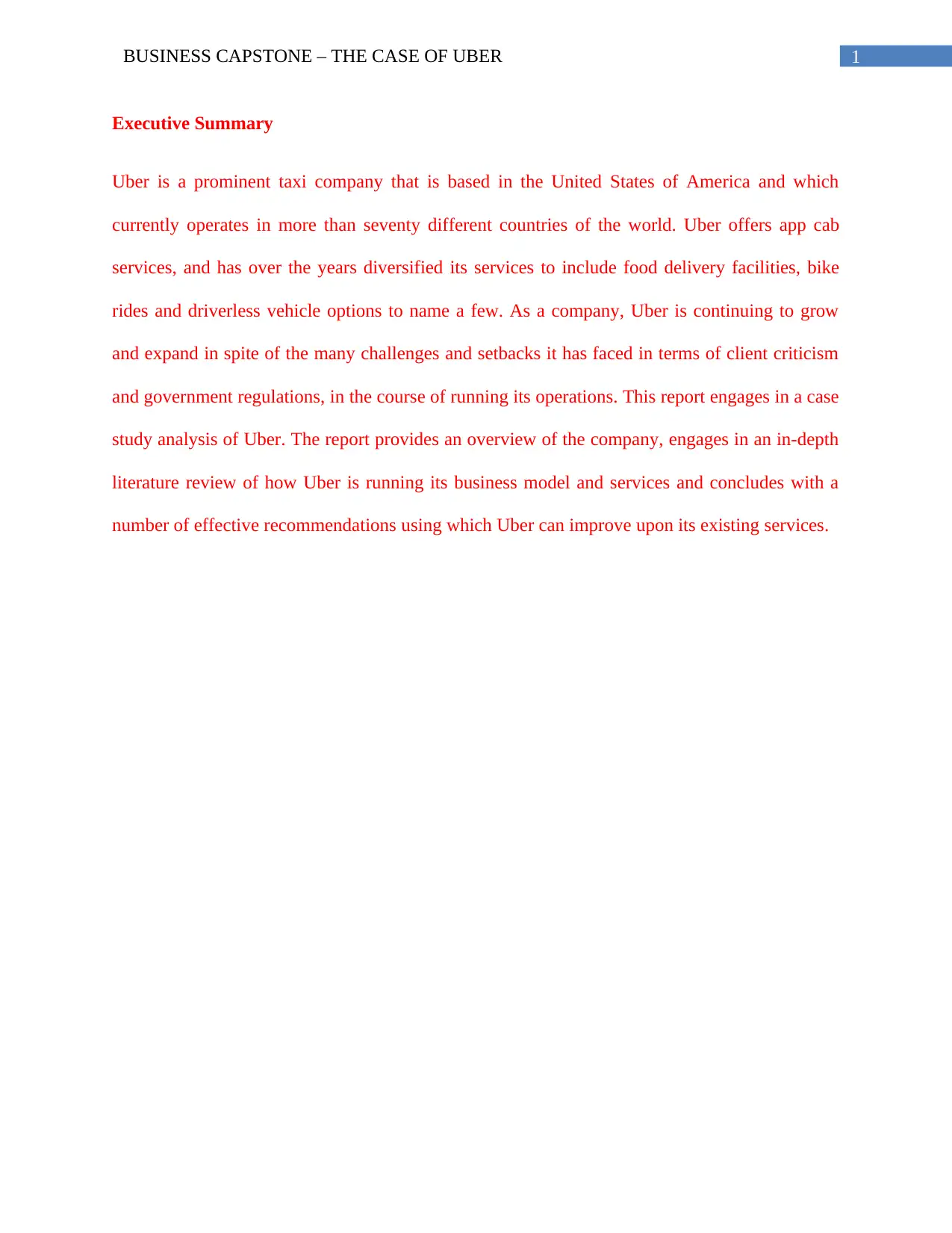
1BUSINESS CAPSTONE – THE CASE OF UBER
Executive Summary
Uber is a prominent taxi company that is based in the United States of America and which
currently operates in more than seventy different countries of the world. Uber offers app cab
services, and has over the years diversified its services to include food delivery facilities, bike
rides and driverless vehicle options to name a few. As a company, Uber is continuing to grow
and expand in spite of the many challenges and setbacks it has faced in terms of client criticism
and government regulations, in the course of running its operations. This report engages in a case
study analysis of Uber. The report provides an overview of the company, engages in an in-depth
literature review of how Uber is running its business model and services and concludes with a
number of effective recommendations using which Uber can improve upon its existing services.
Executive Summary
Uber is a prominent taxi company that is based in the United States of America and which
currently operates in more than seventy different countries of the world. Uber offers app cab
services, and has over the years diversified its services to include food delivery facilities, bike
rides and driverless vehicle options to name a few. As a company, Uber is continuing to grow
and expand in spite of the many challenges and setbacks it has faced in terms of client criticism
and government regulations, in the course of running its operations. This report engages in a case
study analysis of Uber. The report provides an overview of the company, engages in an in-depth
literature review of how Uber is running its business model and services and concludes with a
number of effective recommendations using which Uber can improve upon its existing services.
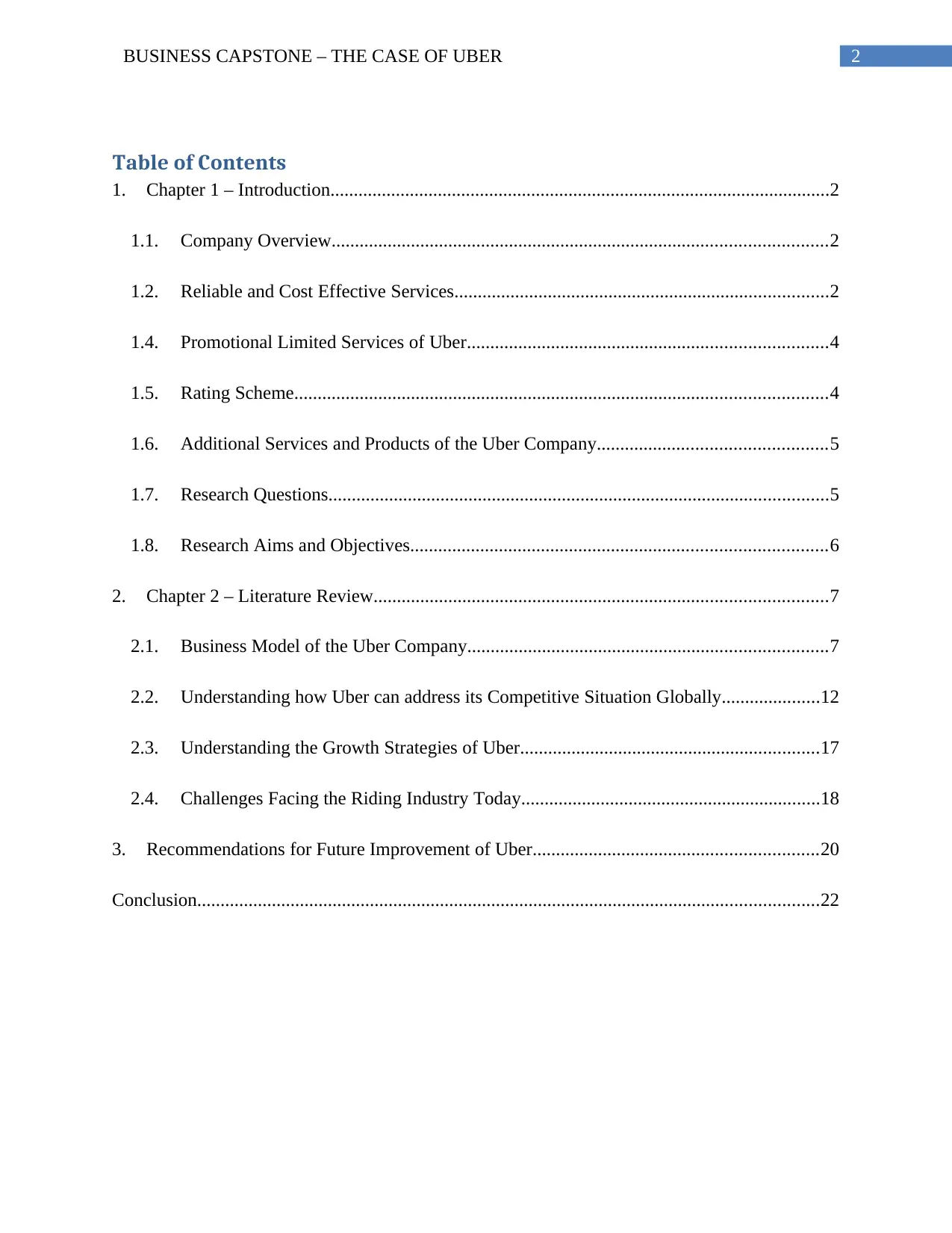
2BUSINESS CAPSTONE – THE CASE OF UBER
Table of Contents
1. Chapter 1 – Introduction...........................................................................................................2
1.1. Company Overview..........................................................................................................2
1.2. Reliable and Cost Effective Services................................................................................2
1.4. Promotional Limited Services of Uber.............................................................................4
1.5. Rating Scheme..................................................................................................................4
1.6. Additional Services and Products of the Uber Company.................................................5
1.7. Research Questions...........................................................................................................5
1.8. Research Aims and Objectives.........................................................................................6
2. Chapter 2 – Literature Review.................................................................................................7
2.1. Business Model of the Uber Company.............................................................................7
2.2. Understanding how Uber can address its Competitive Situation Globally.....................12
2.3. Understanding the Growth Strategies of Uber................................................................17
2.4. Challenges Facing the Riding Industry Today................................................................18
3. Recommendations for Future Improvement of Uber.............................................................20
Conclusion.....................................................................................................................................22
Table of Contents
1. Chapter 1 – Introduction...........................................................................................................2
1.1. Company Overview..........................................................................................................2
1.2. Reliable and Cost Effective Services................................................................................2
1.4. Promotional Limited Services of Uber.............................................................................4
1.5. Rating Scheme..................................................................................................................4
1.6. Additional Services and Products of the Uber Company.................................................5
1.7. Research Questions...........................................................................................................5
1.8. Research Aims and Objectives.........................................................................................6
2. Chapter 2 – Literature Review.................................................................................................7
2.1. Business Model of the Uber Company.............................................................................7
2.2. Understanding how Uber can address its Competitive Situation Globally.....................12
2.3. Understanding the Growth Strategies of Uber................................................................17
2.4. Challenges Facing the Riding Industry Today................................................................18
3. Recommendations for Future Improvement of Uber.............................................................20
Conclusion.....................................................................................................................................22
⊘ This is a preview!⊘
Do you want full access?
Subscribe today to unlock all pages.

Trusted by 1+ million students worldwide
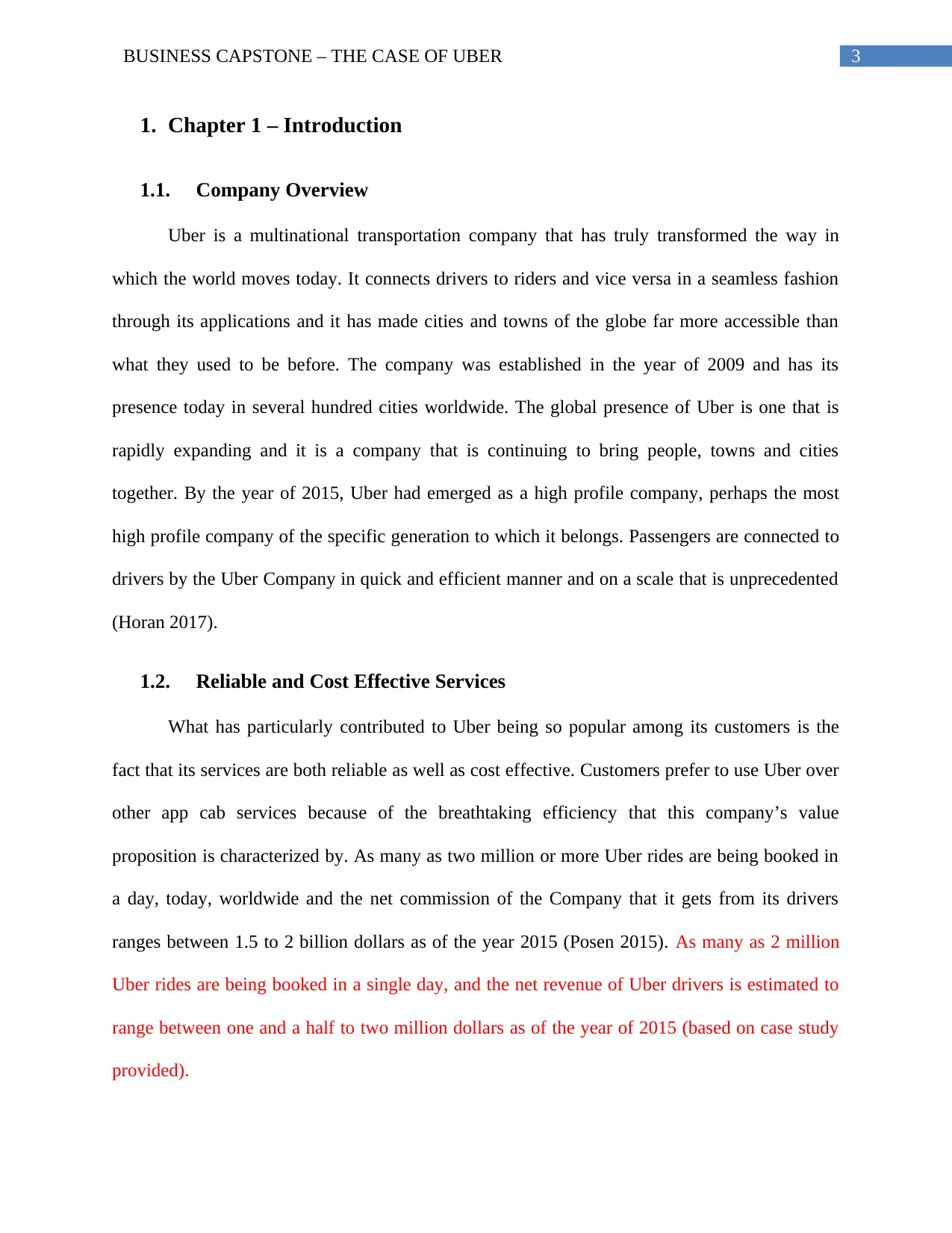
3BUSINESS CAPSTONE – THE CASE OF UBER
1. Chapter 1 – Introduction
1.1. Company Overview
Uber is a multinational transportation company that has truly transformed the way in
which the world moves today. It connects drivers to riders and vice versa in a seamless fashion
through its applications and it has made cities and towns of the globe far more accessible than
what they used to be before. The company was established in the year of 2009 and has its
presence today in several hundred cities worldwide. The global presence of Uber is one that is
rapidly expanding and it is a company that is continuing to bring people, towns and cities
together. By the year of 2015, Uber had emerged as a high profile company, perhaps the most
high profile company of the specific generation to which it belongs. Passengers are connected to
drivers by the Uber Company in quick and efficient manner and on a scale that is unprecedented
(Horan 2017).
1.2. Reliable and Cost Effective Services
What has particularly contributed to Uber being so popular among its customers is the
fact that its services are both reliable as well as cost effective. Customers prefer to use Uber over
other app cab services because of the breathtaking efficiency that this company’s value
proposition is characterized by. As many as two million or more Uber rides are being booked in
a day, today, worldwide and the net commission of the Company that it gets from its drivers
ranges between 1.5 to 2 billion dollars as of the year 2015 (Posen 2015). As many as 2 million
Uber rides are being booked in a single day, and the net revenue of Uber drivers is estimated to
range between one and a half to two million dollars as of the year of 2015 (based on case study
provided).
1. Chapter 1 – Introduction
1.1. Company Overview
Uber is a multinational transportation company that has truly transformed the way in
which the world moves today. It connects drivers to riders and vice versa in a seamless fashion
through its applications and it has made cities and towns of the globe far more accessible than
what they used to be before. The company was established in the year of 2009 and has its
presence today in several hundred cities worldwide. The global presence of Uber is one that is
rapidly expanding and it is a company that is continuing to bring people, towns and cities
together. By the year of 2015, Uber had emerged as a high profile company, perhaps the most
high profile company of the specific generation to which it belongs. Passengers are connected to
drivers by the Uber Company in quick and efficient manner and on a scale that is unprecedented
(Horan 2017).
1.2. Reliable and Cost Effective Services
What has particularly contributed to Uber being so popular among its customers is the
fact that its services are both reliable as well as cost effective. Customers prefer to use Uber over
other app cab services because of the breathtaking efficiency that this company’s value
proposition is characterized by. As many as two million or more Uber rides are being booked in
a day, today, worldwide and the net commission of the Company that it gets from its drivers
ranges between 1.5 to 2 billion dollars as of the year 2015 (Posen 2015). As many as 2 million
Uber rides are being booked in a single day, and the net revenue of Uber drivers is estimated to
range between one and a half to two million dollars as of the year of 2015 (based on case study
provided).
Paraphrase This Document
Need a fresh take? Get an instant paraphrase of this document with our AI Paraphraser
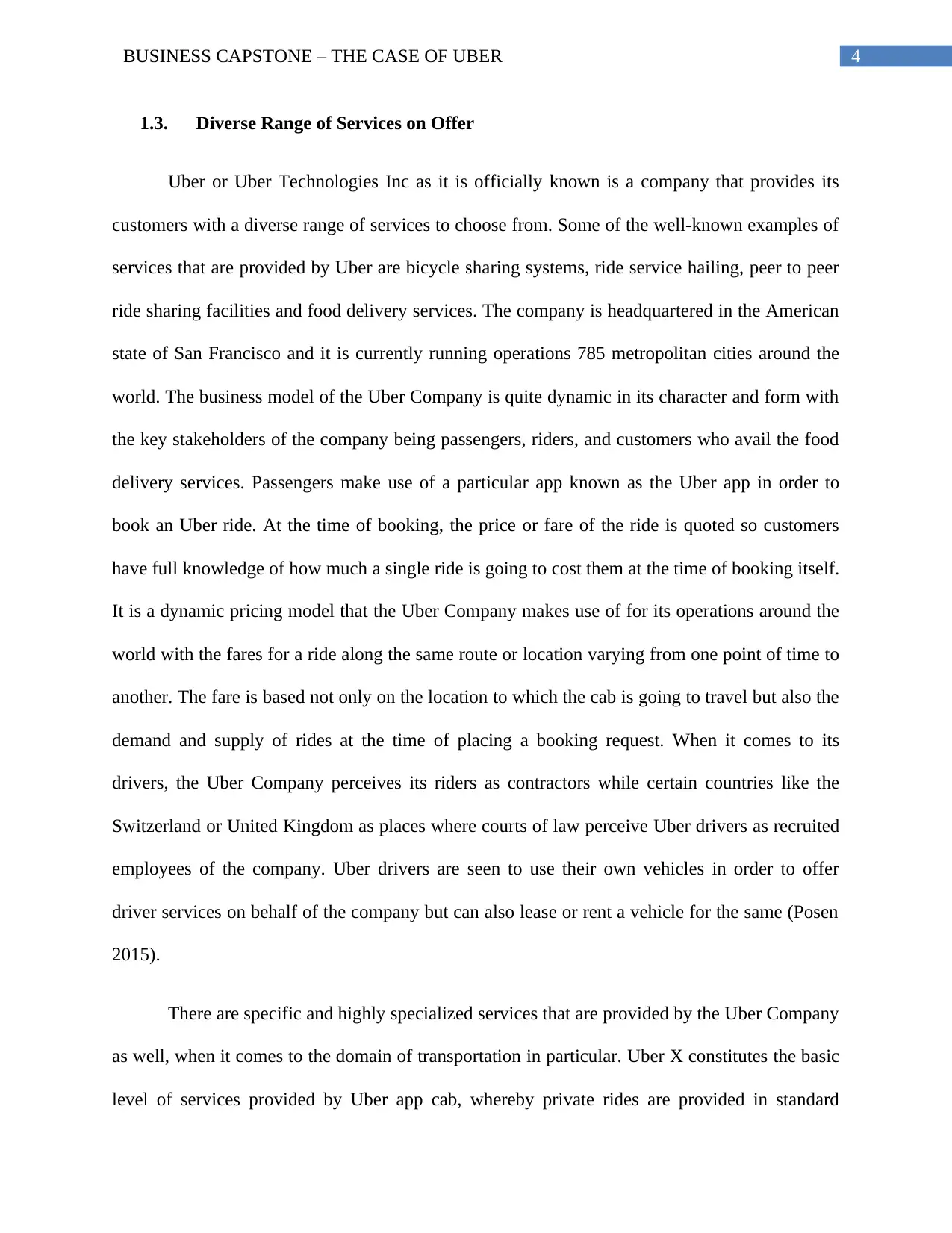
4BUSINESS CAPSTONE – THE CASE OF UBER
1.3. Diverse Range of Services on Offer
Uber or Uber Technologies Inc as it is officially known is a company that provides its
customers with a diverse range of services to choose from. Some of the well-known examples of
services that are provided by Uber are bicycle sharing systems, ride service hailing, peer to peer
ride sharing facilities and food delivery services. The company is headquartered in the American
state of San Francisco and it is currently running operations 785 metropolitan cities around the
world. The business model of the Uber Company is quite dynamic in its character and form with
the key stakeholders of the company being passengers, riders, and customers who avail the food
delivery services. Passengers make use of a particular app known as the Uber app in order to
book an Uber ride. At the time of booking, the price or fare of the ride is quoted so customers
have full knowledge of how much a single ride is going to cost them at the time of booking itself.
It is a dynamic pricing model that the Uber Company makes use of for its operations around the
world with the fares for a ride along the same route or location varying from one point of time to
another. The fare is based not only on the location to which the cab is going to travel but also the
demand and supply of rides at the time of placing a booking request. When it comes to its
drivers, the Uber Company perceives its riders as contractors while certain countries like the
Switzerland or United Kingdom as places where courts of law perceive Uber drivers as recruited
employees of the company. Uber drivers are seen to use their own vehicles in order to offer
driver services on behalf of the company but can also lease or rent a vehicle for the same (Posen
2015).
There are specific and highly specialized services that are provided by the Uber Company
as well, when it comes to the domain of transportation in particular. Uber X constitutes the basic
level of services provided by Uber app cab, whereby private rides are provided in standard
1.3. Diverse Range of Services on Offer
Uber or Uber Technologies Inc as it is officially known is a company that provides its
customers with a diverse range of services to choose from. Some of the well-known examples of
services that are provided by Uber are bicycle sharing systems, ride service hailing, peer to peer
ride sharing facilities and food delivery services. The company is headquartered in the American
state of San Francisco and it is currently running operations 785 metropolitan cities around the
world. The business model of the Uber Company is quite dynamic in its character and form with
the key stakeholders of the company being passengers, riders, and customers who avail the food
delivery services. Passengers make use of a particular app known as the Uber app in order to
book an Uber ride. At the time of booking, the price or fare of the ride is quoted so customers
have full knowledge of how much a single ride is going to cost them at the time of booking itself.
It is a dynamic pricing model that the Uber Company makes use of for its operations around the
world with the fares for a ride along the same route or location varying from one point of time to
another. The fare is based not only on the location to which the cab is going to travel but also the
demand and supply of rides at the time of placing a booking request. When it comes to its
drivers, the Uber Company perceives its riders as contractors while certain countries like the
Switzerland or United Kingdom as places where courts of law perceive Uber drivers as recruited
employees of the company. Uber drivers are seen to use their own vehicles in order to offer
driver services on behalf of the company but can also lease or rent a vehicle for the same (Posen
2015).
There are specific and highly specialized services that are provided by the Uber Company
as well, when it comes to the domain of transportation in particular. Uber X constitutes the basic
level of services provided by Uber app cab, whereby private rides are provided in standard
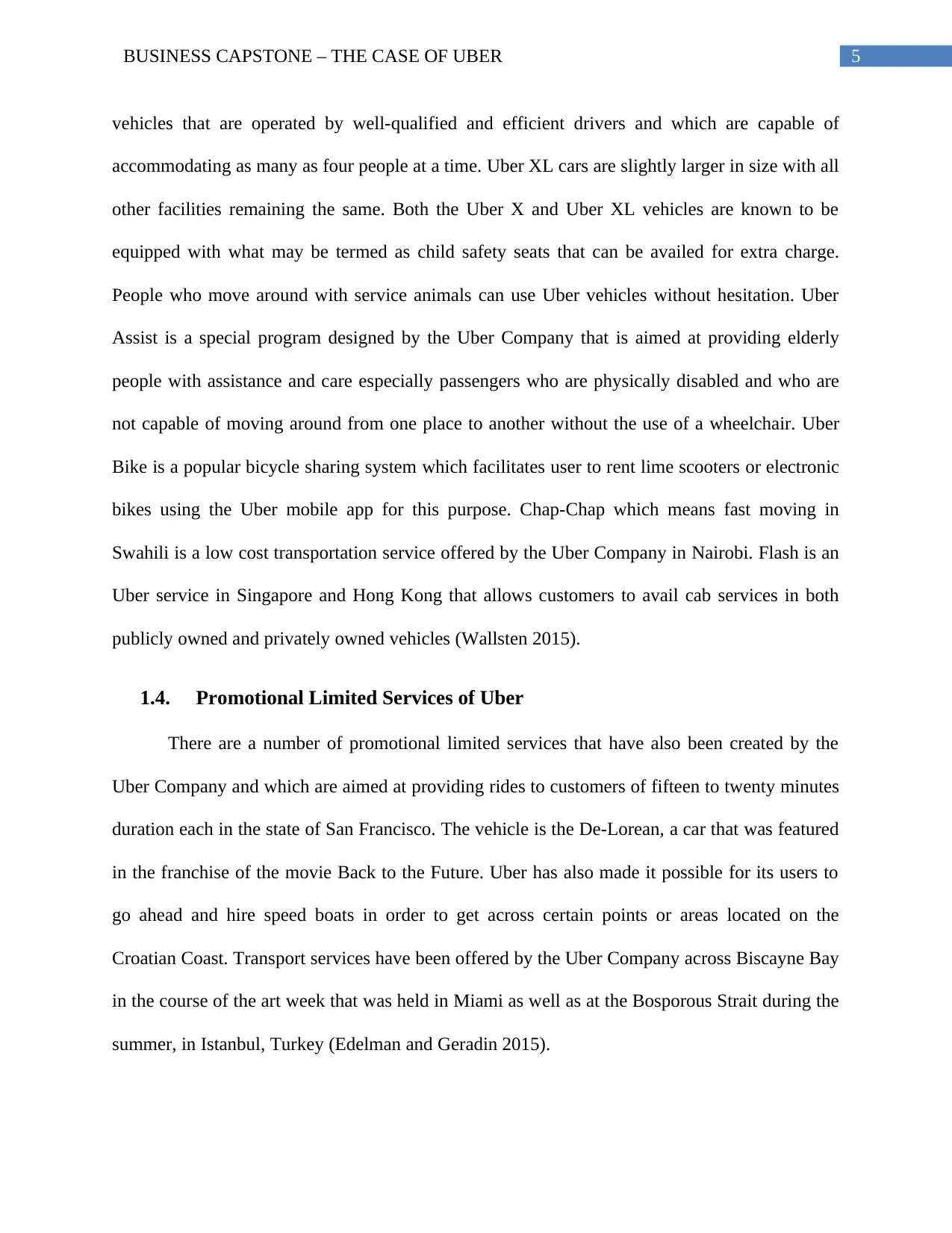
5BUSINESS CAPSTONE – THE CASE OF UBER
vehicles that are operated by well-qualified and efficient drivers and which are capable of
accommodating as many as four people at a time. Uber XL cars are slightly larger in size with all
other facilities remaining the same. Both the Uber X and Uber XL vehicles are known to be
equipped with what may be termed as child safety seats that can be availed for extra charge.
People who move around with service animals can use Uber vehicles without hesitation. Uber
Assist is a special program designed by the Uber Company that is aimed at providing elderly
people with assistance and care especially passengers who are physically disabled and who are
not capable of moving around from one place to another without the use of a wheelchair. Uber
Bike is a popular bicycle sharing system which facilitates user to rent lime scooters or electronic
bikes using the Uber mobile app for this purpose. Chap-Chap which means fast moving in
Swahili is a low cost transportation service offered by the Uber Company in Nairobi. Flash is an
Uber service in Singapore and Hong Kong that allows customers to avail cab services in both
publicly owned and privately owned vehicles (Wallsten 2015).
1.4. Promotional Limited Services of Uber
There are a number of promotional limited services that have also been created by the
Uber Company and which are aimed at providing rides to customers of fifteen to twenty minutes
duration each in the state of San Francisco. The vehicle is the De-Lorean, a car that was featured
in the franchise of the movie Back to the Future. Uber has also made it possible for its users to
go ahead and hire speed boats in order to get across certain points or areas located on the
Croatian Coast. Transport services have been offered by the Uber Company across Biscayne Bay
in the course of the art week that was held in Miami as well as at the Bosporous Strait during the
summer, in Istanbul, Turkey (Edelman and Geradin 2015).
vehicles that are operated by well-qualified and efficient drivers and which are capable of
accommodating as many as four people at a time. Uber XL cars are slightly larger in size with all
other facilities remaining the same. Both the Uber X and Uber XL vehicles are known to be
equipped with what may be termed as child safety seats that can be availed for extra charge.
People who move around with service animals can use Uber vehicles without hesitation. Uber
Assist is a special program designed by the Uber Company that is aimed at providing elderly
people with assistance and care especially passengers who are physically disabled and who are
not capable of moving around from one place to another without the use of a wheelchair. Uber
Bike is a popular bicycle sharing system which facilitates user to rent lime scooters or electronic
bikes using the Uber mobile app for this purpose. Chap-Chap which means fast moving in
Swahili is a low cost transportation service offered by the Uber Company in Nairobi. Flash is an
Uber service in Singapore and Hong Kong that allows customers to avail cab services in both
publicly owned and privately owned vehicles (Wallsten 2015).
1.4. Promotional Limited Services of Uber
There are a number of promotional limited services that have also been created by the
Uber Company and which are aimed at providing rides to customers of fifteen to twenty minutes
duration each in the state of San Francisco. The vehicle is the De-Lorean, a car that was featured
in the franchise of the movie Back to the Future. Uber has also made it possible for its users to
go ahead and hire speed boats in order to get across certain points or areas located on the
Croatian Coast. Transport services have been offered by the Uber Company across Biscayne Bay
in the course of the art week that was held in Miami as well as at the Bosporous Strait during the
summer, in Istanbul, Turkey (Edelman and Geradin 2015).
⊘ This is a preview!⊘
Do you want full access?
Subscribe today to unlock all pages.

Trusted by 1+ million students worldwide
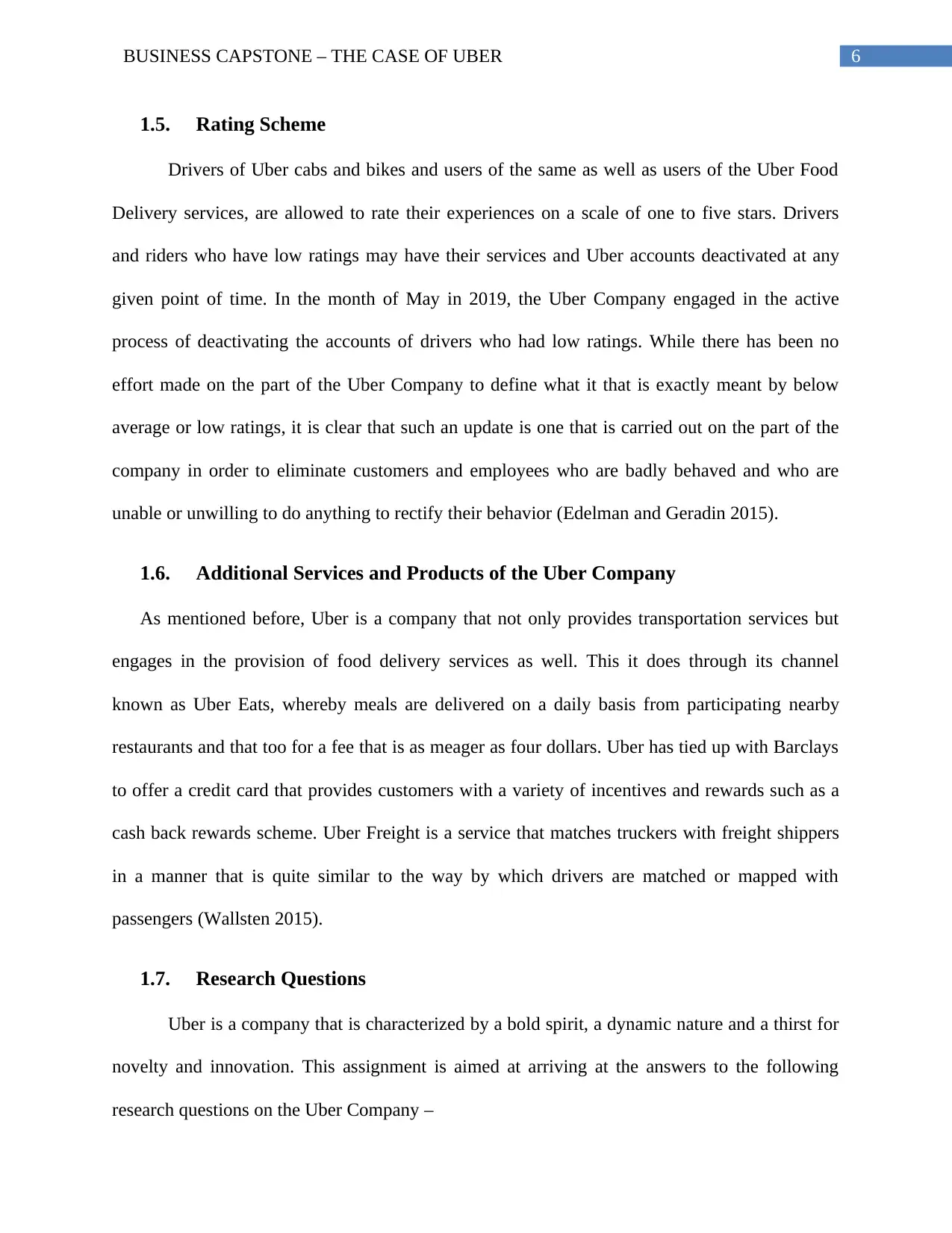
6BUSINESS CAPSTONE – THE CASE OF UBER
1.5. Rating Scheme
Drivers of Uber cabs and bikes and users of the same as well as users of the Uber Food
Delivery services, are allowed to rate their experiences on a scale of one to five stars. Drivers
and riders who have low ratings may have their services and Uber accounts deactivated at any
given point of time. In the month of May in 2019, the Uber Company engaged in the active
process of deactivating the accounts of drivers who had low ratings. While there has been no
effort made on the part of the Uber Company to define what it that is exactly meant by below
average or low ratings, it is clear that such an update is one that is carried out on the part of the
company in order to eliminate customers and employees who are badly behaved and who are
unable or unwilling to do anything to rectify their behavior (Edelman and Geradin 2015).
1.6. Additional Services and Products of the Uber Company
As mentioned before, Uber is a company that not only provides transportation services but
engages in the provision of food delivery services as well. This it does through its channel
known as Uber Eats, whereby meals are delivered on a daily basis from participating nearby
restaurants and that too for a fee that is as meager as four dollars. Uber has tied up with Barclays
to offer a credit card that provides customers with a variety of incentives and rewards such as a
cash back rewards scheme. Uber Freight is a service that matches truckers with freight shippers
in a manner that is quite similar to the way by which drivers are matched or mapped with
passengers (Wallsten 2015).
1.7. Research Questions
Uber is a company that is characterized by a bold spirit, a dynamic nature and a thirst for
novelty and innovation. This assignment is aimed at arriving at the answers to the following
research questions on the Uber Company –
1.5. Rating Scheme
Drivers of Uber cabs and bikes and users of the same as well as users of the Uber Food
Delivery services, are allowed to rate their experiences on a scale of one to five stars. Drivers
and riders who have low ratings may have their services and Uber accounts deactivated at any
given point of time. In the month of May in 2019, the Uber Company engaged in the active
process of deactivating the accounts of drivers who had low ratings. While there has been no
effort made on the part of the Uber Company to define what it that is exactly meant by below
average or low ratings, it is clear that such an update is one that is carried out on the part of the
company in order to eliminate customers and employees who are badly behaved and who are
unable or unwilling to do anything to rectify their behavior (Edelman and Geradin 2015).
1.6. Additional Services and Products of the Uber Company
As mentioned before, Uber is a company that not only provides transportation services but
engages in the provision of food delivery services as well. This it does through its channel
known as Uber Eats, whereby meals are delivered on a daily basis from participating nearby
restaurants and that too for a fee that is as meager as four dollars. Uber has tied up with Barclays
to offer a credit card that provides customers with a variety of incentives and rewards such as a
cash back rewards scheme. Uber Freight is a service that matches truckers with freight shippers
in a manner that is quite similar to the way by which drivers are matched or mapped with
passengers (Wallsten 2015).
1.7. Research Questions
Uber is a company that is characterized by a bold spirit, a dynamic nature and a thirst for
novelty and innovation. This assignment is aimed at arriving at the answers to the following
research questions on the Uber Company –
Paraphrase This Document
Need a fresh take? Get an instant paraphrase of this document with our AI Paraphraser
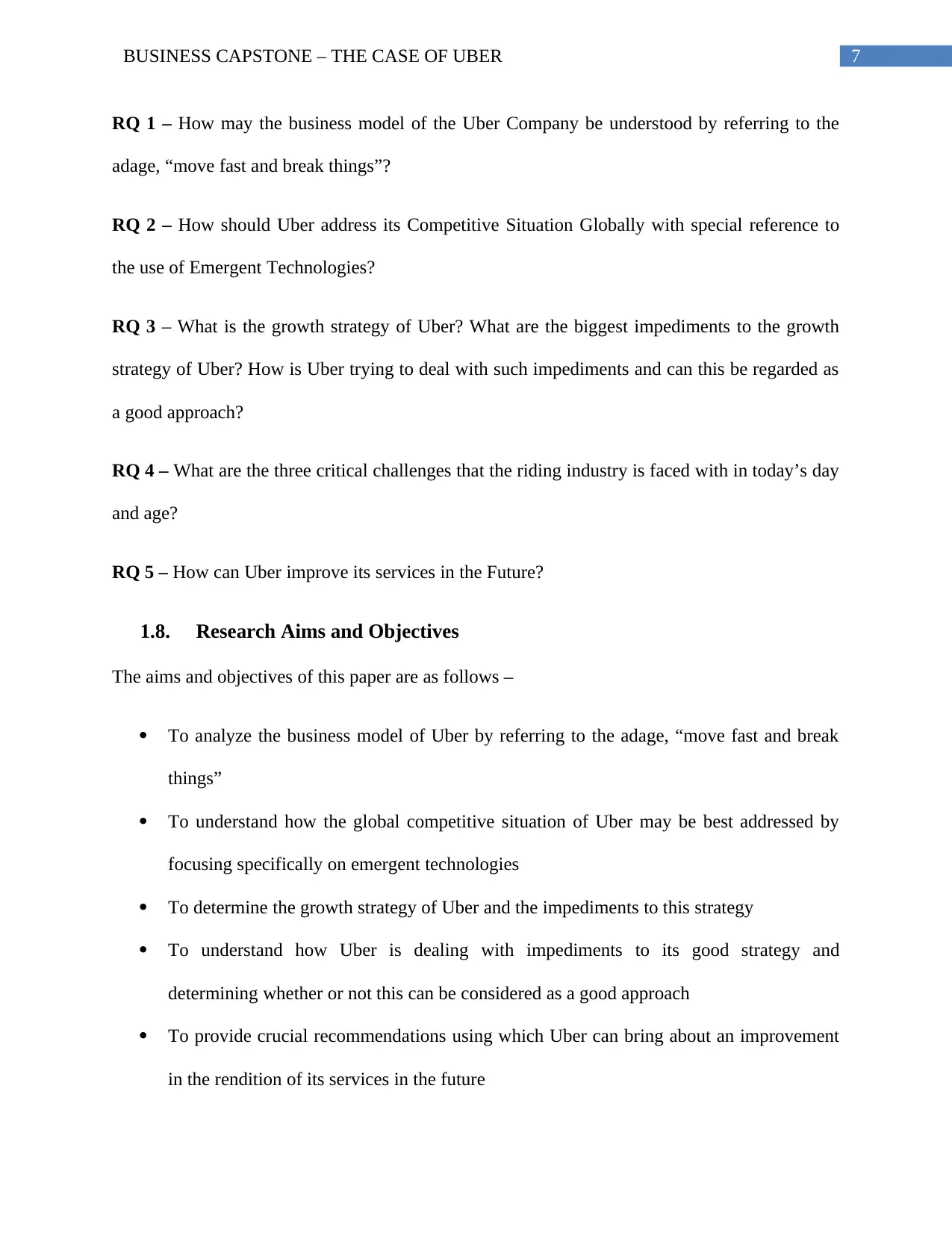
7BUSINESS CAPSTONE – THE CASE OF UBER
RQ 1 – How may the business model of the Uber Company be understood by referring to the
adage, “move fast and break things”?
RQ 2 – How should Uber address its Competitive Situation Globally with special reference to
the use of Emergent Technologies?
RQ 3 – What is the growth strategy of Uber? What are the biggest impediments to the growth
strategy of Uber? How is Uber trying to deal with such impediments and can this be regarded as
a good approach?
RQ 4 – What are the three critical challenges that the riding industry is faced with in today’s day
and age?
RQ 5 – How can Uber improve its services in the Future?
1.8. Research Aims and Objectives
The aims and objectives of this paper are as follows –
To analyze the business model of Uber by referring to the adage, “move fast and break
things”
To understand how the global competitive situation of Uber may be best addressed by
focusing specifically on emergent technologies
To determine the growth strategy of Uber and the impediments to this strategy
To understand how Uber is dealing with impediments to its good strategy and
determining whether or not this can be considered as a good approach
To provide crucial recommendations using which Uber can bring about an improvement
in the rendition of its services in the future
RQ 1 – How may the business model of the Uber Company be understood by referring to the
adage, “move fast and break things”?
RQ 2 – How should Uber address its Competitive Situation Globally with special reference to
the use of Emergent Technologies?
RQ 3 – What is the growth strategy of Uber? What are the biggest impediments to the growth
strategy of Uber? How is Uber trying to deal with such impediments and can this be regarded as
a good approach?
RQ 4 – What are the three critical challenges that the riding industry is faced with in today’s day
and age?
RQ 5 – How can Uber improve its services in the Future?
1.8. Research Aims and Objectives
The aims and objectives of this paper are as follows –
To analyze the business model of Uber by referring to the adage, “move fast and break
things”
To understand how the global competitive situation of Uber may be best addressed by
focusing specifically on emergent technologies
To determine the growth strategy of Uber and the impediments to this strategy
To understand how Uber is dealing with impediments to its good strategy and
determining whether or not this can be considered as a good approach
To provide crucial recommendations using which Uber can bring about an improvement
in the rendition of its services in the future
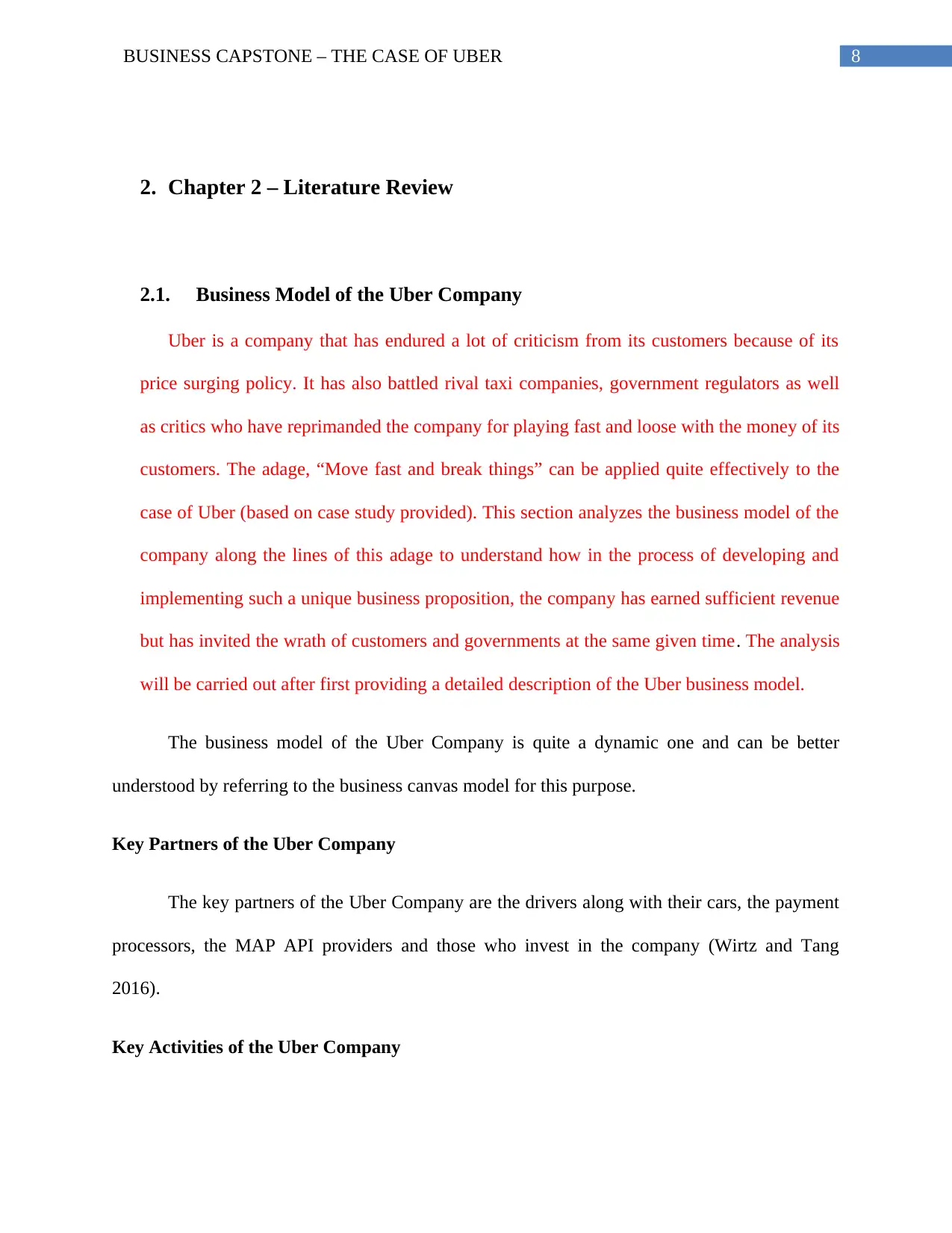
8BUSINESS CAPSTONE – THE CASE OF UBER
2. Chapter 2 – Literature Review
2.1. Business Model of the Uber Company
Uber is a company that has endured a lot of criticism from its customers because of its
price surging policy. It has also battled rival taxi companies, government regulators as well
as critics who have reprimanded the company for playing fast and loose with the money of its
customers. The adage, “Move fast and break things” can be applied quite effectively to the
case of Uber (based on case study provided). This section analyzes the business model of the
company along the lines of this adage to understand how in the process of developing and
implementing such a unique business proposition, the company has earned sufficient revenue
but has invited the wrath of customers and governments at the same given time. The analysis
will be carried out after first providing a detailed description of the Uber business model.
The business model of the Uber Company is quite a dynamic one and can be better
understood by referring to the business canvas model for this purpose.
Key Partners of the Uber Company
The key partners of the Uber Company are the drivers along with their cars, the payment
processors, the MAP API providers and those who invest in the company (Wirtz and Tang
2016).
Key Activities of the Uber Company
2. Chapter 2 – Literature Review
2.1. Business Model of the Uber Company
Uber is a company that has endured a lot of criticism from its customers because of its
price surging policy. It has also battled rival taxi companies, government regulators as well
as critics who have reprimanded the company for playing fast and loose with the money of its
customers. The adage, “Move fast and break things” can be applied quite effectively to the
case of Uber (based on case study provided). This section analyzes the business model of the
company along the lines of this adage to understand how in the process of developing and
implementing such a unique business proposition, the company has earned sufficient revenue
but has invited the wrath of customers and governments at the same given time. The analysis
will be carried out after first providing a detailed description of the Uber business model.
The business model of the Uber Company is quite a dynamic one and can be better
understood by referring to the business canvas model for this purpose.
Key Partners of the Uber Company
The key partners of the Uber Company are the drivers along with their cars, the payment
processors, the MAP API providers and those who invest in the company (Wirtz and Tang
2016).
Key Activities of the Uber Company
⊘ This is a preview!⊘
Do you want full access?
Subscribe today to unlock all pages.

Trusted by 1+ million students worldwide
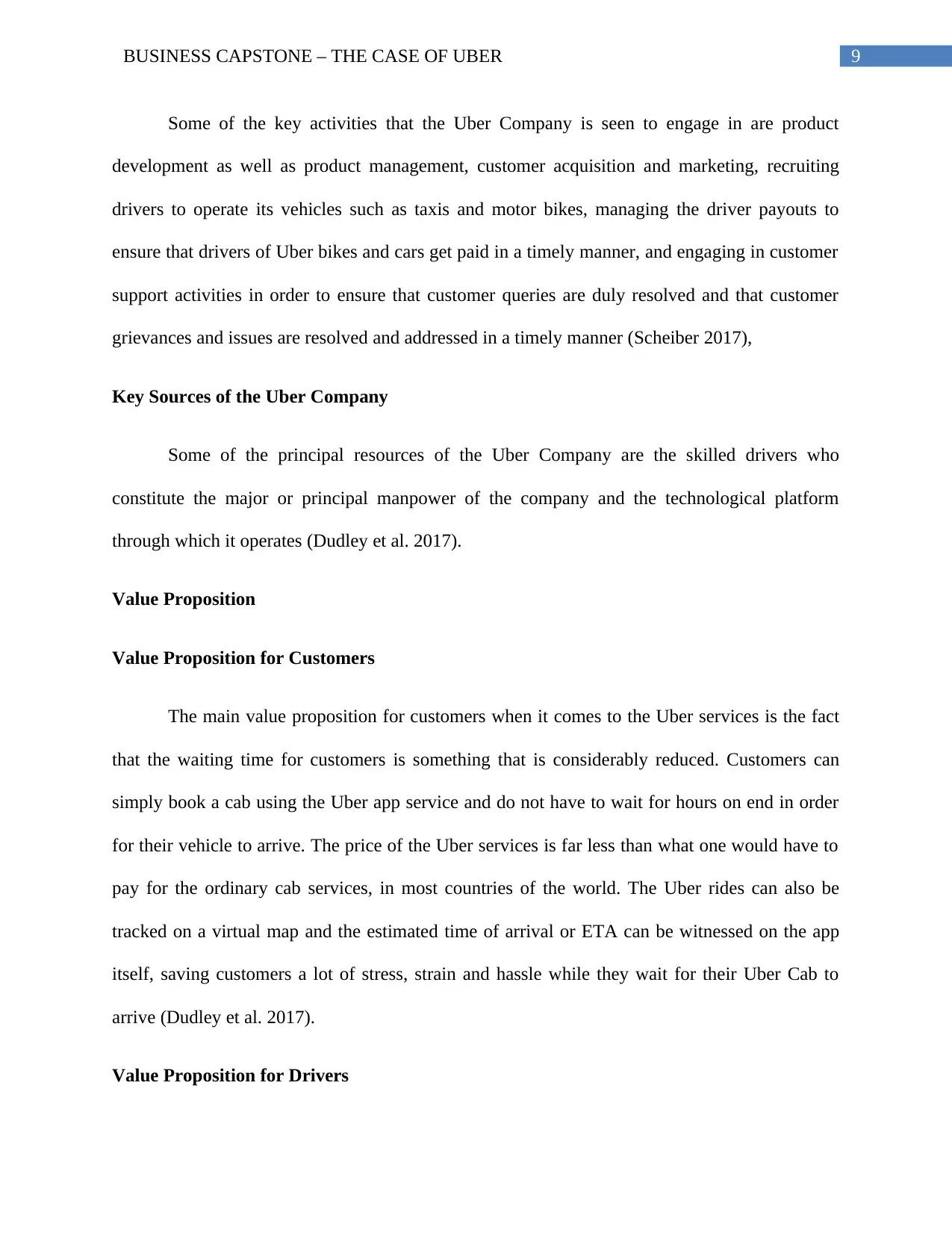
9BUSINESS CAPSTONE – THE CASE OF UBER
Some of the key activities that the Uber Company is seen to engage in are product
development as well as product management, customer acquisition and marketing, recruiting
drivers to operate its vehicles such as taxis and motor bikes, managing the driver payouts to
ensure that drivers of Uber bikes and cars get paid in a timely manner, and engaging in customer
support activities in order to ensure that customer queries are duly resolved and that customer
grievances and issues are resolved and addressed in a timely manner (Scheiber 2017),
Key Sources of the Uber Company
Some of the principal resources of the Uber Company are the skilled drivers who
constitute the major or principal manpower of the company and the technological platform
through which it operates (Dudley et al. 2017).
Value Proposition
Value Proposition for Customers
The main value proposition for customers when it comes to the Uber services is the fact
that the waiting time for customers is something that is considerably reduced. Customers can
simply book a cab using the Uber app service and do not have to wait for hours on end in order
for their vehicle to arrive. The price of the Uber services is far less than what one would have to
pay for the ordinary cab services, in most countries of the world. The Uber rides can also be
tracked on a virtual map and the estimated time of arrival or ETA can be witnessed on the app
itself, saving customers a lot of stress, strain and hassle while they wait for their Uber Cab to
arrive (Dudley et al. 2017).
Value Proposition for Drivers
Some of the key activities that the Uber Company is seen to engage in are product
development as well as product management, customer acquisition and marketing, recruiting
drivers to operate its vehicles such as taxis and motor bikes, managing the driver payouts to
ensure that drivers of Uber bikes and cars get paid in a timely manner, and engaging in customer
support activities in order to ensure that customer queries are duly resolved and that customer
grievances and issues are resolved and addressed in a timely manner (Scheiber 2017),
Key Sources of the Uber Company
Some of the principal resources of the Uber Company are the skilled drivers who
constitute the major or principal manpower of the company and the technological platform
through which it operates (Dudley et al. 2017).
Value Proposition
Value Proposition for Customers
The main value proposition for customers when it comes to the Uber services is the fact
that the waiting time for customers is something that is considerably reduced. Customers can
simply book a cab using the Uber app service and do not have to wait for hours on end in order
for their vehicle to arrive. The price of the Uber services is far less than what one would have to
pay for the ordinary cab services, in most countries of the world. The Uber rides can also be
tracked on a virtual map and the estimated time of arrival or ETA can be witnessed on the app
itself, saving customers a lot of stress, strain and hassle while they wait for their Uber Cab to
arrive (Dudley et al. 2017).
Value Proposition for Drivers
Paraphrase This Document
Need a fresh take? Get an instant paraphrase of this document with our AI Paraphraser
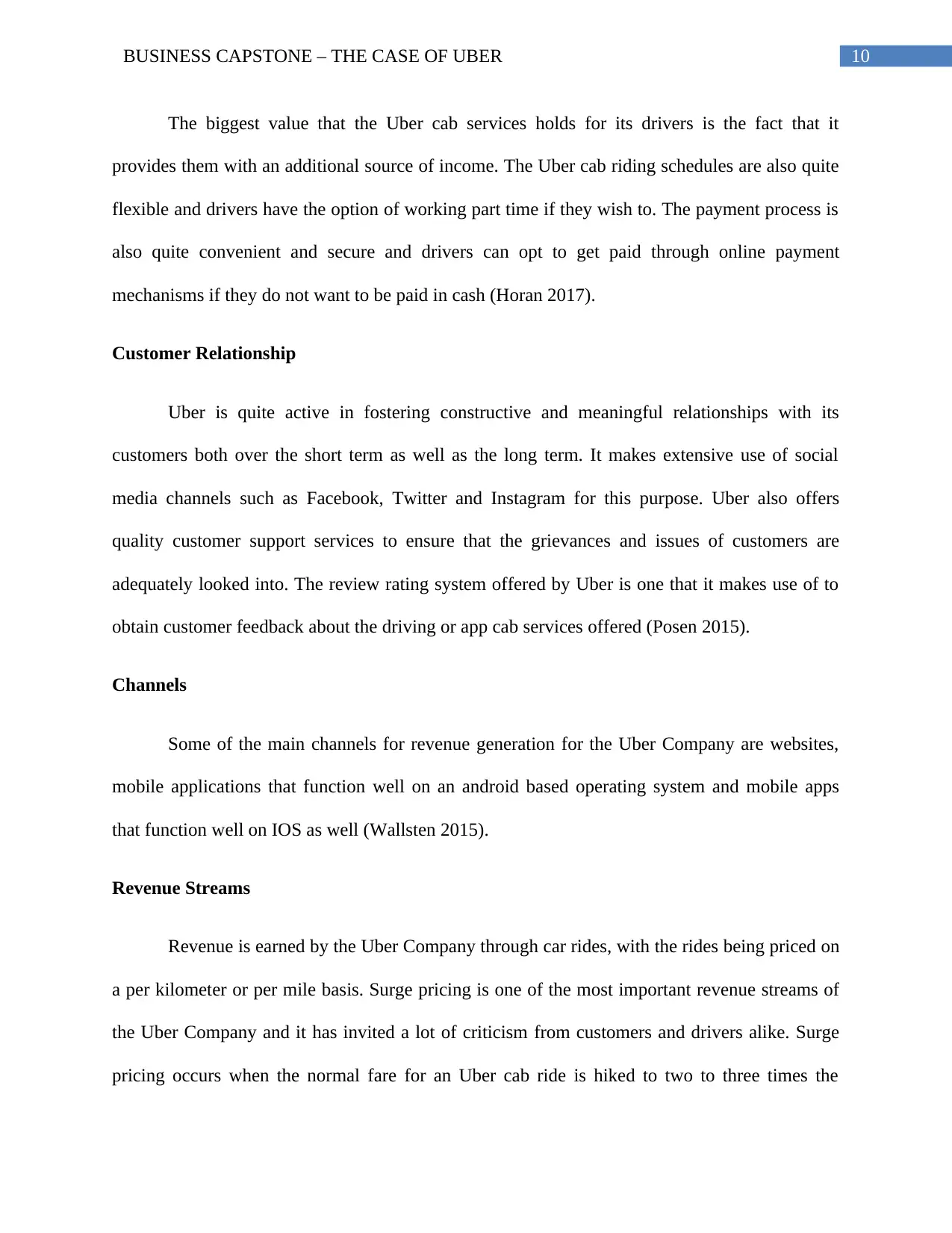
10BUSINESS CAPSTONE – THE CASE OF UBER
The biggest value that the Uber cab services holds for its drivers is the fact that it
provides them with an additional source of income. The Uber cab riding schedules are also quite
flexible and drivers have the option of working part time if they wish to. The payment process is
also quite convenient and secure and drivers can opt to get paid through online payment
mechanisms if they do not want to be paid in cash (Horan 2017).
Customer Relationship
Uber is quite active in fostering constructive and meaningful relationships with its
customers both over the short term as well as the long term. It makes extensive use of social
media channels such as Facebook, Twitter and Instagram for this purpose. Uber also offers
quality customer support services to ensure that the grievances and issues of customers are
adequately looked into. The review rating system offered by Uber is one that it makes use of to
obtain customer feedback about the driving or app cab services offered (Posen 2015).
Channels
Some of the main channels for revenue generation for the Uber Company are websites,
mobile applications that function well on an android based operating system and mobile apps
that function well on IOS as well (Wallsten 2015).
Revenue Streams
Revenue is earned by the Uber Company through car rides, with the rides being priced on
a per kilometer or per mile basis. Surge pricing is one of the most important revenue streams of
the Uber Company and it has invited a lot of criticism from customers and drivers alike. Surge
pricing occurs when the normal fare for an Uber cab ride is hiked to two to three times the
The biggest value that the Uber cab services holds for its drivers is the fact that it
provides them with an additional source of income. The Uber cab riding schedules are also quite
flexible and drivers have the option of working part time if they wish to. The payment process is
also quite convenient and secure and drivers can opt to get paid through online payment
mechanisms if they do not want to be paid in cash (Horan 2017).
Customer Relationship
Uber is quite active in fostering constructive and meaningful relationships with its
customers both over the short term as well as the long term. It makes extensive use of social
media channels such as Facebook, Twitter and Instagram for this purpose. Uber also offers
quality customer support services to ensure that the grievances and issues of customers are
adequately looked into. The review rating system offered by Uber is one that it makes use of to
obtain customer feedback about the driving or app cab services offered (Posen 2015).
Channels
Some of the main channels for revenue generation for the Uber Company are websites,
mobile applications that function well on an android based operating system and mobile apps
that function well on IOS as well (Wallsten 2015).
Revenue Streams
Revenue is earned by the Uber Company through car rides, with the rides being priced on
a per kilometer or per mile basis. Surge pricing is one of the most important revenue streams of
the Uber Company and it has invited a lot of criticism from customers and drivers alike. Surge
pricing occurs when the normal fare for an Uber cab ride is hiked to two to three times the
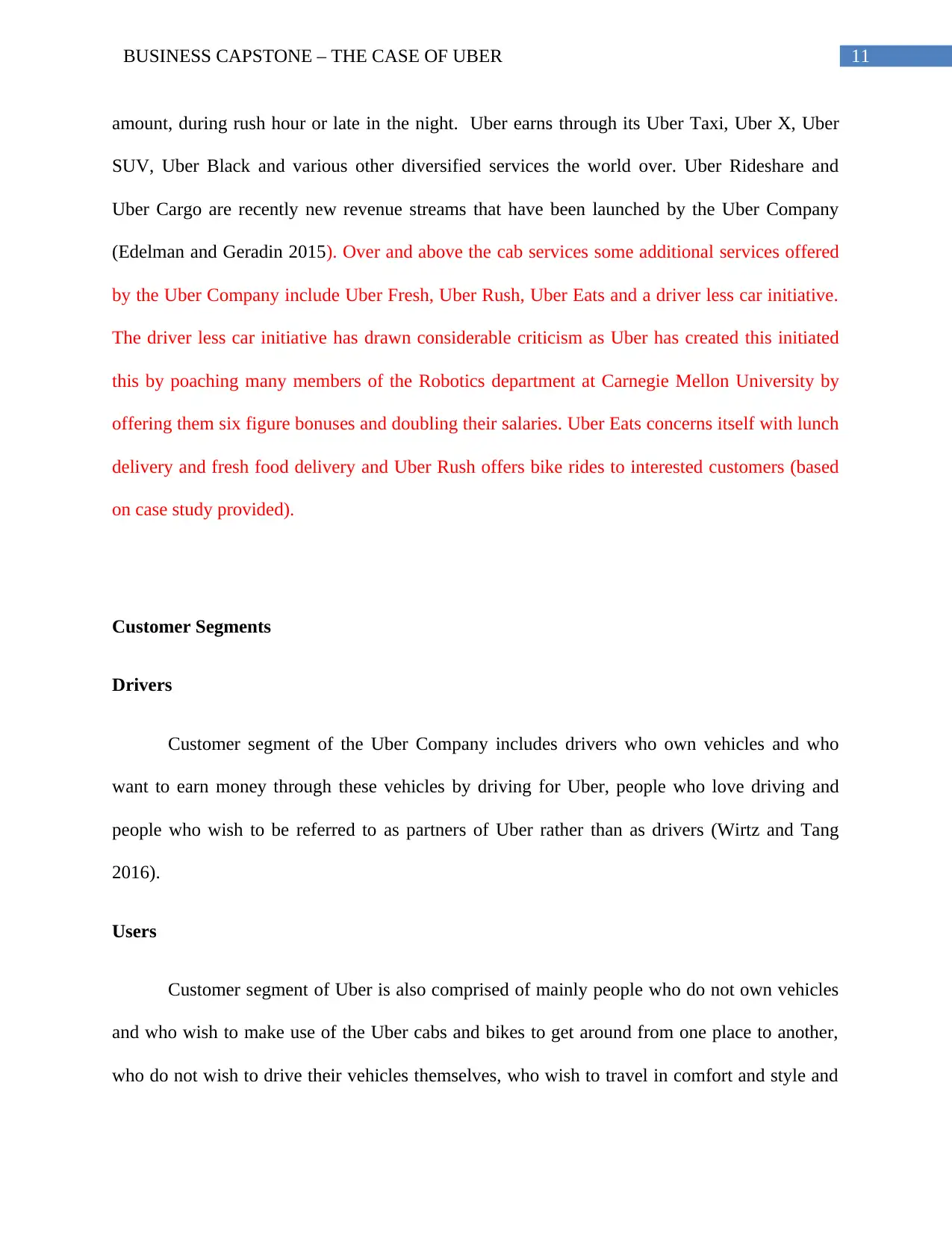
11BUSINESS CAPSTONE – THE CASE OF UBER
amount, during rush hour or late in the night. Uber earns through its Uber Taxi, Uber X, Uber
SUV, Uber Black and various other diversified services the world over. Uber Rideshare and
Uber Cargo are recently new revenue streams that have been launched by the Uber Company
(Edelman and Geradin 2015). Over and above the cab services some additional services offered
by the Uber Company include Uber Fresh, Uber Rush, Uber Eats and a driver less car initiative.
The driver less car initiative has drawn considerable criticism as Uber has created this initiated
this by poaching many members of the Robotics department at Carnegie Mellon University by
offering them six figure bonuses and doubling their salaries. Uber Eats concerns itself with lunch
delivery and fresh food delivery and Uber Rush offers bike rides to interested customers (based
on case study provided).
Customer Segments
Drivers
Customer segment of the Uber Company includes drivers who own vehicles and who
want to earn money through these vehicles by driving for Uber, people who love driving and
people who wish to be referred to as partners of Uber rather than as drivers (Wirtz and Tang
2016).
Users
Customer segment of Uber is also comprised of mainly people who do not own vehicles
and who wish to make use of the Uber cabs and bikes to get around from one place to another,
who do not wish to drive their vehicles themselves, who wish to travel in comfort and style and
amount, during rush hour or late in the night. Uber earns through its Uber Taxi, Uber X, Uber
SUV, Uber Black and various other diversified services the world over. Uber Rideshare and
Uber Cargo are recently new revenue streams that have been launched by the Uber Company
(Edelman and Geradin 2015). Over and above the cab services some additional services offered
by the Uber Company include Uber Fresh, Uber Rush, Uber Eats and a driver less car initiative.
The driver less car initiative has drawn considerable criticism as Uber has created this initiated
this by poaching many members of the Robotics department at Carnegie Mellon University by
offering them six figure bonuses and doubling their salaries. Uber Eats concerns itself with lunch
delivery and fresh food delivery and Uber Rush offers bike rides to interested customers (based
on case study provided).
Customer Segments
Drivers
Customer segment of the Uber Company includes drivers who own vehicles and who
want to earn money through these vehicles by driving for Uber, people who love driving and
people who wish to be referred to as partners of Uber rather than as drivers (Wirtz and Tang
2016).
Users
Customer segment of Uber is also comprised of mainly people who do not own vehicles
and who wish to make use of the Uber cabs and bikes to get around from one place to another,
who do not wish to drive their vehicles themselves, who wish to travel in comfort and style and
⊘ This is a preview!⊘
Do you want full access?
Subscribe today to unlock all pages.

Trusted by 1+ million students worldwide
1 out of 28
Related Documents
Your All-in-One AI-Powered Toolkit for Academic Success.
+13062052269
info@desklib.com
Available 24*7 on WhatsApp / Email
![[object Object]](/_next/static/media/star-bottom.7253800d.svg)
Unlock your academic potential
Copyright © 2020–2025 A2Z Services. All Rights Reserved. Developed and managed by ZUCOL.





